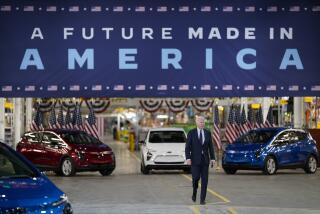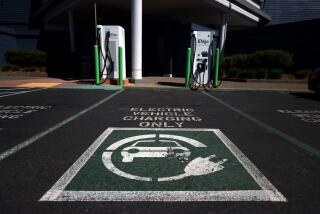To Save Energy, Oceans, Billions--and the Air We Breathe
SNOWMASS, COLO. â Theyâre at it again.
The same people who brought us gasoline lines and brownouts are warning us of more of the same--while they advocate policies that could make their warnings come true.
Not that we donât have a choice. Since 1979, Americans have gotten more than seven times as much new energy from savings as from all net increases of supply, and more new supply from renewable sources than from fossil and nuclear fuels. Savings achieved since 1973 are saving $150 billion in annual energy costs today--more than $600 a year, tax-free, in every Americanâs pocket. Even so, weâve barely scratched the surface of how much efficiency is available and worth buying.
Yet listening to the presidential campaign, one might think none of these striking advances had in fact been made; that our energy choices remain limited essentially to the same old disagreeable supply options--oil, coal and nuclear. Consider, for example, the decision made Oct. 3 by the National Highway Traffic Safety Administration, an obscure and unaccountable branch of the federal Department of Transportation, to roll back the federal new-car efficiency standards for the fourth consecutive year, in response to pleas by General Motors and Ford that higher standards would force cutbacks of big-car production and cost hundreds of thousands of jobs.
Congress adopted the standards in 1975 in order to reduce U.S. dependency on imported oil. Before the imposition of fuel-efficiency standards, there was little incentive for consumers to buy cars that used less fuel. Of the total driving cost of a typical car, less than a fifth is fuel; a more efficient car can cost about as much more to buy as it costs less to run. Without the threat of federal gas-guzzler penalties, buyers would thus be indifferent to whether a car gets 20 miles per gallon or 60.
Yet choices toward the lower end of this fuel-efficiency range incur enormous costs for everyone. Persian Gulf oil imports, which the United States could eliminate by a 3-m.p.g. gain in fleet efficiency, are costing this country $50 billion a year in military bills for patrolling the gulf. As for environmental considerations, gas-guzzling autos spew air pollutants--a typical car emits nearly its own weight in carbon every year, contributing to global warming.
Congressâ 1975 standards embodied a strong social interest in efficient cars--and the standards worked. In recent years, new domestic cars grew increasingly efficient, while imports that got 30-m.p.g.-plus--too efficient to be constrained by the standards--were getting less efficient as fuel prices fell.
Moreover, the cars now sold in Europe and Japan are scarcely more efficient than the average car sold in the United States. But Europe and Japan achieved those efficiency levels at enormous cost, via fuel excise taxes (a different form of government intervention) that raised gasoline prices several times above the U.S. level. U.S. standards achieved virtually the same result at far lower cost. Federal analysts found that it cost manufacturers at most $80 billion to achieve light-vehicle efficiency gains from 1975 to 1987, but that the increased efficiency saved American consumers a cumulative $260 billion (in 1987 dollars) in fuel costs.
The 1975 car standards were thus a howling success--one of the most effective oil-saving measures the world has ever known. They caused a fifth of all the oil savings achieved during 1979-83 by the 21 non-communist nations in the International Energy Agency. But of the domestic auto-makers, only Chrysler complied with the standards: General Motors and Ford have flunked them for each of the past six model years, disingenuously claiming helplessness in the face of a âconsumer preferenceâ that they assiduously manipulate to favor their least efficient but most profitable models.
GM and Ford used a loophole written into law in 1979 to avoid paying statutory fines for their non-compliance. In 1985, however, they could no longer carry forward earlier âovercomplianceâ credits to offset continuing non-compliance. This left them liable for something like $1.2 billion in federal fines (the actual figure remains an official secret). To avoid this distasteful imposition, the Reagan Administration made an administrative finding--apparently challengeable in court only by auto-makers themselves--that the 27.5-m.p.g. standard originally mandated for 1986-88 cars was no longer âfeasibleâ and would be rolled back to 26 m.p.g. GM and Ford could then âovercomplyâ with the reduced standard, wiping out their fines. Learning that they could defy Congress with impunity, the two companies intensified their already active marketing of inefficient models--while Chrysler was competitively penalized for consistently obeying the law.
This favor to corporate friends, however, did even more damage: It instantly doubled American oil imports from the Persian Gulf. During 1979-85, thanks largely to the federal standards, fleet efficiency steadily improved. But the 1986 rollback slashed that rate of improvement by 81%, to a 10-year low, while a simultaneous rollback in light-truck standards cut that fleetâs gains by 67%. The result: an increase of roughly 295,300 barrels a day in crude-oil requirements. Thatâs exactly the rate at which proposed oil wells to be drilled in the Arctic Refuge are hoped to yield over 30 years. Thus the Administration wants to seek new oil to offset the oil itâs just wasted--both at great cost.
More broadly, gains in light-vehicle efficiency were the backbone of a remarkable achievement during 1977-85: U.S. oil productivity, measured by gross national product achieved per barrel burned, rose at an average rate of 5% per year. That was four-fifths faster than needed to keep up with both economic growth and shrinking domestic oil output. The result: a steady fall in oil imports to half the former total. But in 1986, the standards rollback triggered a costly and ominous resurgence of imports.
What on earth was our government thinking about? Rhetorically, American jobs. Imports are taking a record share of the car market. But thatâs surely not because of the standards--they apply to all manufacturers, and hence canât skew competition. GM and Ford gripe that Japanese competition is especially severe for the most profitable âluxuryâ end of their market. So it is--partly because, restricted by quotas on the number (not the value) of cars they can export, Japanese car-makers naturally export higher-value cars. But this erosion of American big-car sales should make compliance with the efficiency standards easier, not harder; the falloff is due to American buyersâ perceptions of relative quality and value, not to the standards.
Indeed, the standards helped to save GM and Ford from annihilation in the smaller-model market. If enforced, they would also help prepare Detroit for competition in the future world of high oil prices. At least seven foreign manufacturers have already tested safe, high-performance prototype cars getting from 67 to 121 miles per gallon. Some reportedly cost no more to make than todayâs models.
Another red herring: To rationalize the 1989 rollback to 26.5 m.p.g. (the level GM and Ford said they could tolerate), it was argued that lightweight cars are inherently unsafe. In fact, some of the safest cars on the road today are small and light--they are just well-engineered.
Of course, in obscure administrative hearings subject to no effective judicial review--which led up to the Oct. 3 decision--this Administration can and does find whatever GM and Ford want. Until Congress stops this circumvention of its intent, light-vehicle standards can continue to be gutted for these firmsâ marketing convenience. But the costs to the nation will mount, including billions of dollars in extra oil imports each year, dirtier air, lost markets and jobs in a less competitive auto industry--and increased âgreenhouse effectâ global warming.
Fuel standards arenât the only way to avoid these costs. An even better way would be for states like California to tax inefficient new vehicles and rebate the taxes to buyers of efficient new vehicles. The result would be cleaner air, greater energy security, unsullied coastal resources and new net wealth from fuel dollars saved.
Combined with todayâs best techniques for saving oil in other vehicles, industry and buildings, super-efficient cars hold promise of saving three-fourths of all oil now used in the United States. Capturing even part of this potential could eliminate oil imports and save trillions of dollars--enough, in the long run, to pay off the entire national debt.
More to Read
Inside the business of entertainment
The Wide Shot brings you news, analysis and insights on everything from streaming wars to production â and what it all means for the future.
You may occasionally receive promotional content from the Los Angeles Times.










